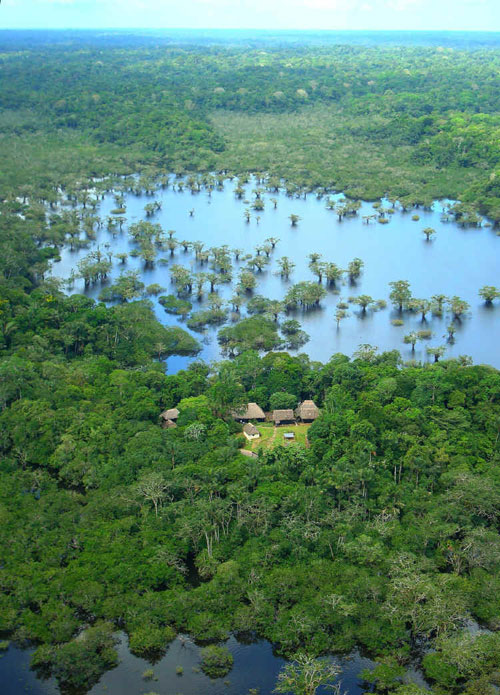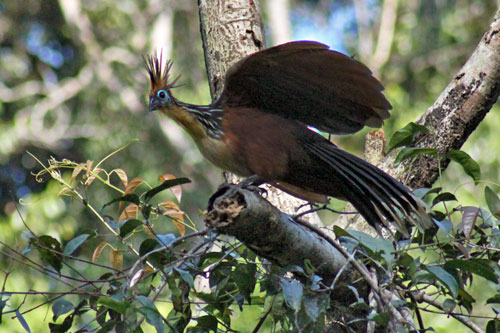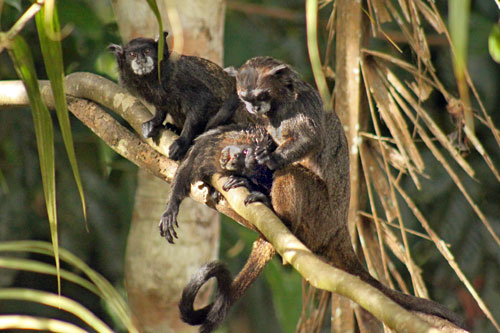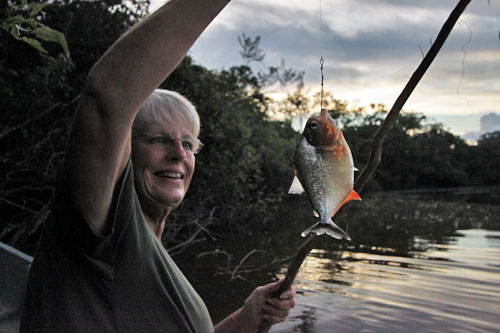No matter what I tried, I could not get dry. I showered and toweled off, put on one of two pair of pants and T-shirts I had carried into the Amazon jungle, and within minutes of stepping into the unforgiving Equatorial sun, my sweat-soaked clothes were stuck to me like a second skin. To put it bluntly, after two days at Cuyabeno Lodge I stank. It was a relief to climb into bed each night, pull the mosquito net around me, and lie spread-eagle and motionless as the exotic sounds of the jungle lulled me to sleep.
My journey around Ecuador had previously taken me to the Galapagos Islands; the dry coastal plains around Puerto Lopez, with their immense stretches of beach and surf; and the central mountains, home to one of the world’s highest capital cities, Quito, but these three zones combined make up only half of the area of the country. The remainder is covered by tropical rainforests and my trip to Ecuador would not have been complete without visiting what is known as Amazonas.

With such a vast area, options for visiting the Amazon jungle are myriad, however I had an advantage when it came to choosing a specific destination. My friend Heather Cowper, who writes the popular travel blog Heather on her Travels, highly recommended Cuyabeno National Park in the far northeast corner of Ecuador, one of very few inundated tropical rainforests in the world. My first hint that this would be an out-of-the-ordinary adventure came when the owners of Cuyabeno Lodge briefed me about the trip. From Quito I would need to take a seven-hour bus ride to the town of Lago Agrio, where I would be met by their guide for another two-hour van ride to the entrance of the National Park. There I would transfer to a boat for an additional 2.5-hour ride on the Cuyabeno River to the Grand Lagoon. Since the last leg would be accomplished in small motorized canoes, space for luggage was limited to a small backpack; their parting advice was to pack only lightweight, quick-drying pants and shirts, a comment I glossed over and promptly dismissed, to my later dismay.
The following evening I boarded the Esmeraldas bus bound for Lago Agrio and sank gratefully into my front row seat, hoping to fall fast asleep, but the moment we headed down the mountain it became clear this would not be a comfortable trip. For three hours the road plummeted at a grade so steep that I had to brace my feet against the front wall to keep from sliding out of my seat. At the foot of the mountain we entered steamy lowlands bordering the jungle, forcing me to peel off layers of clothing that had kept me warm through Quito’s chilly nights. Finally, I dozed, only to be rudely awakened when the pavement ended and our bus jounced over rough graveled roads and across a series of rickety metal bridges with narrow wooden planks barely wide enough for the tires. By the light of the full moon I could just make out the glistening rivers far below and my mind conjured images of tumbling to the bottom of the gorges.

As the eastern horizon was blinking pink we pulled into Lago Agrio, a prosperous town on the edge of the jungle where giant refineries process the abundant petroleum being extracted from the Amazon basin. Now in a private van, we traveled a newly paved road that cut a serpentine path through dense vegetation, bordered the entire way by a huge pipeline through which flowed black gold. Two hours later we arrived at the park entrance and transferred to a dugout canoe painted in faded bright colors for our transfer to the lodge. I tottered down the narrow floorboard of the boat and commandeered a rough wooden plank behind our heaped luggage, exhilarated from a combination of sleep deprivation and the foreign landscape that lay before me.

With wind blowing through my hair and the coffee-colored Cuyabeno River at my fingertips we motored deep into the Amazon, past serpents sunning on muddy banks and exotic Hoatzin birds perched on overarching branches. Suddenly, the river broadened into a vast lagoon where azure skies dotted with cotton-ball clouds framed palm-crowned islands. Our boatman deftly steered around giant trees with wide buttressed trunks protruding from the black water and beached the boat on a muddy bank leading to the high ridge where our cabins awaited.
Can’t see the above slide show of Cuyabeno National Park in the Amazon jungle of Ecuador? Click here.
For the next three days we plied the rivers in search of exotic birds, reptiles, and insects. One day brought sightings of four different primate species: two tiny night monkeys peered out from a tree hollow; a mob of squirrel monkeys flew through the forest on a highway of dead limbs; a Satanic-looking Capuchin monkey bared fangs from a high perch; and an endangered Parahuaco Monkey with an incredibly long, thick tail flew between branches like a trapeze artist. One night we swept the inky waters with flashlights until the yellow eyes of a caiman gleamed back at us; we motored within inches of the nine-foot long submerged beast and gaped at its immense head and jaws. Another night I was totally unnerved by a giant Wolf Spider clinging to a leaf just inches from my leg as we trekked through the jungle after dark.

Even the afternoon I opted to stay at the lodge rather than trek was spectacular; Black Tamarin Monkeys groomed one another and nursed babies hanging from their teats just feet from the lodge’s open-air dining room. But my favorite moment of all was on the final day, when we paddled to a quiet bay in the lagoon just before sunset and baited bamboo fishing poles with hunks of beef in hopes of hooking a Piranha. Within seconds the flesh-eating fish struck, deftly nibbling the beef, but try as I might I could not set the hook. I was down to my last hunk of beef and had just about given up hope when a perfectly-timed snap of the pole brought up a White Piranha. Our guide cautiously extracted the hook and displayed the fish’s razor sharp teeth before releasing it, giving me pause about a suggestion earlier in the day that we could swim in the lagoon.

I almost took them up on the offer as a means of doing my laundry. By that time, I had tried to spot-wash my stinking clothes in the sink with the biodegradable soap provided by the lodge, but that was an exercise in futility. Unfortunately, my pants were not lightweight and after hanging two days in the tropical humidity they were still not dry. I boarded the bus back to Quito with a backpack full of damp, reeking clothes, wearing my least dirty trousers and T-shirt, painfully aware of my own stench. I tried keeping the window partially open to minimize the smell but temperatures dropped as we headed up the mountain and every time I opened my window, the person in front of me closed it. I suffered in silence, wondering what my seatmate must be thinking and consoling myself with the thought that it was a small price to pay for the once-in-a-lifetime opportunity to visit the Amazon.
Visiting Cuyabeno Lodge
Cuyabeno Lodge, the oldest accommodation and first ecotourism facility within the 1,500,000 acre Cuyabeno National Park, is operated by international conservationists who helped create and protect the park. Every bit of building material for the facility was trucked in to the border of the reserve and transported by canoe to the building site, rather than using trees from ecologically sensitive areas. Because cabins have only waist-high walls topped by roll-down wooden blinds I had visions of jaguars jumping through my windows as I slept but the only critters I had to oust were beautifully colored giant cockroaches. Once I got rid of the undesirable bugs, sleeping was quite pleasant, as the nights cooled down to very comfortable temperatures and the exotic sounds of the jungle quickly lulled me to sleep. Each cabin is furnished with a comfortable bed, mosquito netting, lukewarm-water showers and a small desk. Though the cabins are lit by generator every evening, electric receptacles are available only in the kitchen, however the staff takes great pains to recharge batteries for guests’ electronic equipment.
Cuyabeno Lodge kindly hosted the author’s visit to the Cuyabeno National Park in Ecuador. However, the receipt and acceptance of complimentary items/services received will never influence the content, topics, or posts in this blog. I write the truth, the whole truth, and nothing but the truth.

I enјoy what you guyѕ аre
up too. Suсh clever work and coνerage!
Keep up the good woгks guys І’ve included you guys
to my blogroll.
Loved reading this article from you, as I went to this lodge when I was in Ecuador for 3 days. Pretty much everything you wrote about was dead and it was a highlight for me in Ecuador. Did you get to go to a local jungle village at all when there though? That might have been the best thing about it for me. I never wrote about it but you can check out a few photos I took while there. Was Roger your boat captain? http://www.facebook.com/media/set/?set=a.10150479704395785.365918.147277205784&type=1
Hi foggodyssey! Thanks so much for commenting. I did get to the Siona village and will be producing a video about it at some point. Such a great place, except for the sweat 🙂 Can’t remember the name of our boat captain, but I’m pretty sure it wasn’t Roger. Someday I’d love to go back and visit Yasuni Park, a bit further south than Cuyabeno.
Woow… I loved these photographs… Amazon is a thrill-seeker’s paradise…very well captured..
Unquestionably believe that which you stated. Your favorite reason appeared to be on the net the simplest thing to be aware of. I say to you, I certainly get annoyed while people consider worries that they just don’t know about. You managed to hit the nail upon the top as well as defined out the whole thing without having side effect, people could take a signal. Will likely be back to get more. Thanks.
You just gave me a reason to go to South America. You have temped me with what sounds to be such an amazing experience! I love that you had to go on all of that transportation to get there. I don’t love the S word…spider…but I could live with it if it meant experiencing the Amazon this way – so authentically!
Sherry, it’ really an incredible experience. The Amazon jungle especially – my visit there has inspired me to go to Brazil just to sail down the real Amazon River!
So, so much wildlife you’ve captured on camera while there, it’s really amazing how much variety of life exists in rain forests. Though my ‘s’ word would be snakes, and I think it’s because they bother me so much that I run into them all the time!
When most people think Amazon, Brazil is the first place that comes to mind. To be honest I’ve never considered Ecuador for an Amazon experience, but your unique adventure got me thinking about the possibility of exploring this beautiful region. Thanks!
Maria, I had the exact same impression! Before arriving in Ecuador I had no idea so much of the country was covered by Amazon tropical rainforest. And now that I’m in Peru I find the same here – so many ways to visit the jungle in these two countries.
Hi I am a big reader, would really appreciate an invite. Your blog is very nice and I really enjoy the style and content. Thanks.
I have always felt attracted by the amazing nature and the jungle, but indeed, if I am honest, this places scare me… I mean I would love to have a look at pictures, read about the rain forest and jungle or watch films, but can not imagine myself there indeed!
Thanks so much for your great comments. Sabine, the key is to have a good guide. I would NEVER venture into a place like this on my own and indeed, the government requires visitors to be guided.
One word Barbara. Wow! Your travels are always fueled with adventure, and your writing never disappoints.
Great article. The Amazon has always intrigued me, and this sounds like a great place to experience it and see some of the wildlife.
Thank you for this wonderful article and all of your articles on Ecuador. My husband and I have a one-way ticket to Ecuador next summer (the first stop on our RTW trip). When I tell people we are starting in Ecuador most say “Huh. Why Ecuador?” But we are so excited to experience the diverse country and a trip to the Amazon is on our “must do” list. Unfortunately, it looks like the cost of traveling to the Galapagos will keep us away. Maybe someday…
Kim: Think again about the Galapagos. Don’t book ahead. One you get to Quito, look around for a tour agency who can add you to a last minute trip; they sell these for way lower than normal just to fill up the space. I met numerous people who got 4-5 day cruises for between $400 to $500, including wet suit and snorkeling gear. There’s a hostel in Quito – in the San Blas neighborhood – called Secret Garden. Inside there’s a travel agency that comes highly recommended. Keep in mind that if you don’t book it this year you’ll never again have a chance to see so many of the islands for such a low price, because the law changes January 1st and boats will only be able to visit each island once every 15 days.
Barbara, My husband and I have been tossing around the idea of traveling to the Galapagos for our 5 year anniversary, and like Kim and her husband, the cost was keeping us from making a solid decision. Ecuador was also on our list so I’m going to share this article with him and hopefully this will rekindle our plans!
Hi Mindy: Just a quick note about one thing that may tip the balance in your decision whether or not to go to the Galapagos. The law will soon change, making it illegal for any boat to visit an island more than once each 15 days. Thus, what I was able to see in 8 days will take 15 days, making the price much steeper. Ecoventura, the company that provided my trip and whom I highly recommend, will be revising their schedule to three 5-day cruises. You will be able to take all three cruises back-to-back to see all the islands, two 5-day cruises back-to-back, or just one. If you go soon, you might still be able to get a 7 night/8 day itinerary that goes to all the islands.
I’m finding the more I travel, the more I hate hot, humid climates. But I guess it’s the price we pay to visit the great places that are located in those climates! Looks like a great trip. I love the picture of you with the piranha!
It is a good article, the Amazon is beautiful, ecuador has great biodiversity and forests, is a gran reserva ecologica. Ist time to know ecuador http://www.viventura.com/tours/ecuador
The Amazon is truly one of thr world’s great treasures. I experienced it in Peru along similar lines of a long journey and loved every minute of it. It rained one evening (great to reduce the temperature a little) like I have never seen rain and loved the whole feel of the place. Let’s hope that we can protect it and theat the Brazilian government (and others) can be urged to not dam it, not sell too much for timber, farmland, mineral or oil production and preserve the wonderful communities that continue to battle out their old-style existence. Really great article that captures the heart of the Amazon. Let’s hope that a Stumble helps more share it.
This made for good reading, sounds like a real adventure. I had never really considered the Amazon, but your article is quite inspiring.
Babara, fascinating article and stunning photos as always. I would love to go there!
Hi Julia! I definitely got “sticky feet” in Ecuador, as they say but don’t at all regret staying two months. And when I left a week ago, there were still things I wanted to see. But the Amazon ran a close second to the Galapagos and I wouldn’t have missed it for the world – stink and all!
Bookmarked this page. Ecuador just jumped higher on my list. So if enough people visit, ecotourism might preempt oil, hey, Heather?
I didn’t get to Cuyabeno when I was in Ecuador but it sounds a fantastic opportunity to see the Amazon wildlife at close hand. Of course if the oil companies have their way all this would be destroyed, so It’s a case of visit and enjoy or lose it.
Hi Heather. Thought you had been to Cuyabeno – what a shame that you missed it! You are so right about the oil companies, but at least the present administration has taken measures to protect the Yasuni Park in the Amazon through a very unique program that I’ll be writing about sometime soon.